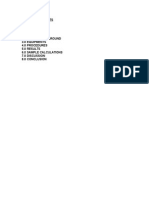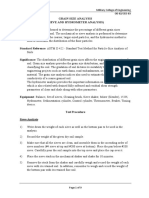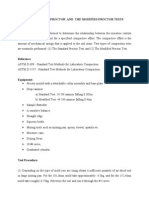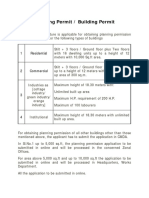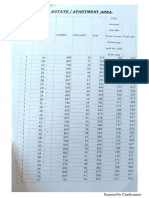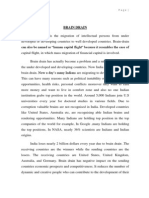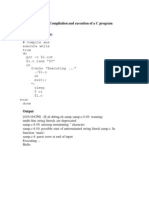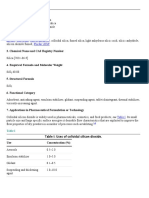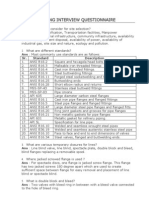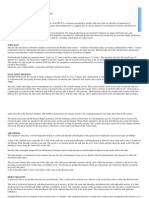Soil Manual FINAL
Soil Manual FINAL
Uploaded by
Subramaniam GanesanCopyright:
Available Formats
Soil Manual FINAL
Soil Manual FINAL
Uploaded by
Subramaniam GanesanOriginal Description:
Copyright
Available Formats
Share this document
Did you find this document useful?
Is this content inappropriate?
Copyright:
Available Formats
Soil Manual FINAL
Soil Manual FINAL
Uploaded by
Subramaniam GanesanCopyright:
Available Formats
Ex No: 1 GRAIN SIZE DISTRIBUTION SIEVE ANALYSIS METHOD
Date:
Aim:
To determine the distribution of coarse grain size larger than 75 microns of a soil and
to classify the given coarse grained soil.
Apparatu R!"uir!#:
Mechanical sieve shaker, Set of S Sieves, !alance accurate to ".#g, Sieve brusher,
and Soil sam$le.
$ormu%a:
%i& 'ercentage retained on any sieve
( %)eight of soil retained*Total soil +eight& , #""-
%ii& .umulative $ercentage retained on any sieve
( Sum of $ercentages retained on all coarser sieves
%iii& 'ercentage finer than any other sieve size
( %#"" / cumulative $ercentage retained on that sieve&
Data R!pr!!&tatio&:
The grain size distribution of a soil is $resented as a curve on a semi/logarithmic $lot, the
ordinate being the $ercentage finer than any other sieve size +hereas the $article size is
re$resented on a logarithmic scale in abscissa.
The general slo$e and sha$e of the distribution curve can be described by
means of coefficient of uniformity %.
u
& and the coefficient of curvature %.
c
& defined as
follo+s.
.
u
( D
0"
* D
#"
.
c
( D
1"
2
D
0" 3
D
#"
The $article size such that #"- of the $articles are smaller than that size is denoted by D
#"
Size D
#"
is defined as the 4effective size5. 6ther sizes such as D
1"
and D
0"
can be defined in a
similar +ay.
#
Ta'u%atio&:
)eight of soil sam$le taken for analysis (
IS Si!(!
#!i)&atio&
i& mm*
+!i),t o- oi%
r!tai&!#
i& .)/*
0!r1!&ta)!
r!tai&!# i&
2
3umu%ati(!
p!r1!&t
r!tai&!# i& 2
0!r1!&t -i&!r
i& 2*
2
0ro1!#ur!:
#& Take the 2""/1""g of oven dry soil as a re$resentative sam$le from a bag of material.
2& 'lace the S Sieve in order %i.e.& starting from 7.75mm to 75 microns at the bottom.
1& The +eighed oven dried sam$le is $laced on 7.75mm sieve. Then the sieving should
continue for at least #" minutes in a mechanical sieve shaker.
7& The sam$le retained in each sieve should be +eighed. The $ercentage retained on
each sieve is com$uted by dividing the +eight retained on each sieve by the original
sam$le +eight.
5& Then the $ercent finer is com$uted by starting +ith #"" $ercent and subtracting the
$ercent retained on each sieve as cumulative $rocedure.
0& The coefficient of uniformity and coefficient of curvature is calculated using the
formula.
R!u%t:
8ffective size, D
#"
%mm& (
9niformity coefficient .u (
.urvature coefficient .c (
:ravel ( -
Sand ( -
.oarse sand ( -
Medium sand ( -
;ine sand ( -
Silt and clay ( -
1
7
Ex No: 4 GRAIN SIZE DISTRIBUTION HYDROMETER
Dat!: ANALYSIS METHOD
Aim:
To determine the grain size distribution of the given soil sam$le +ith significant
fraction $assing through 75micron sieve and its classification.
Apparatu r!"uir!#:
#. <ydrometer
2. Thermo meter
1. :lass =ar
7. Dis$ersing agent solution
5. )eighing balance
0. Sto$ +atch.
$ormu%a U!#:
;rom Stokes >a+
D ( ? @1"A * BC" % :
s
/:
+
&D E ? %F
r
*t&
G ( @#"" :
s
* )
s
%:
s
/#&D E Hc
)here,
A ( Iiscosity of fluid in dyne/sec*cm
2
:
s
( S$ecific gravity of soil traction
:
+
( S$ecific gravity of +ater
F
r
( <eight of fall, in cm
t ( time of fall, in minutes
D ( diameter of $articles, in mm
)
d
()eight of dry soil sam$le taken in gms.
Hc (hydrometer reading corrected for meniscus, dis$ersing agent and tem$erature.
3orr!1tio& app%i!# to H5#rom!t!r t!t
#. Meniscus correction %.
m
& (
2. Dis$ersing agent correction %.
d
& (
1. Tem$erature .orrection %.t&
The hydrometer is usually calibrated to measure the s$ecific gravity of a fluid at a $articular
calibration tem$erature, normally 2"
J
c. ;or other tem$eratures, a correction is reKuired and
this may be com$uted from
.
t
( %% :
+c
/:
+t
&D E a
v
%T
c
&&#"
1
:
+c
( S$ecific gravity of +ater at calibration tem$erature
:
+t
( S$ecific gravity of tem$erature of test
F
r
( Iolume coefficient of e,$ansion of glass
5
Ta'u%atio&:
<ydrometer Go (
)eight of dry soil taken for analysis, )s (
S$ecific gravity of soil solids, :s (
Dis$ersing agent correction, .d (
Meniscus correction, .m (
E%ap!#
tim! i&
mi&
T!mp
i& 63
H5#rom!t!r
r!a#i&) R7
,
M!&i1u
1orr!1tio
& R
,
8R7
,
9 3
m
T!mp!ratur!
1orr!1tio&
3
t
3om'i&!#
1orr!1tio&
383
m
93
#
93
t
3orr!1t!#
,5#rom!t!r
R!a#i&)
R18 R7
,
93
Z
r
Diam!t!r
D
N2
L
#
2
7
C
#5
1"
0"
#2"
27"
7C"
#77"
0ro1!#ur!:
0
.alibration of hydrometer
Iolume of hydrometer
#& mmerse the hydrometer in $artially filled measuring cylinder and note do+n the
dis$lacement of +ater, +hich is eKual to the volume of the hydrometer in milliliters
%ml&.
2& Mrea of the cross section of the measurement cylinder measuring the distance in cm,
bet+een t+o graduation on the cylinder area of cross section then eKual to the volume
included bet+een t+o graduation divided by the distance bet+een them.
1& Nee$ the hydrometer on the +hite $a$er. Dra+ its boundaries and mark the ma=or
calibration and mark it on the $a$er.
7& Measure the height of the bulb from the neck to the bottom of the bulb.
5& Measure the height %<& bet+een the neck and each ma=or calibration mark %H
h
&.
0& Hecord the values of < Is H
h
table and calculate the effective de$th of the
corres$onding to each of the ma=or calibration mark H
h
.
<
c
( < O %>*2& , %h P %I
h
*2&&
7& Dra+ the calibration curve <
v
and H
h
.
S!#im!&tatio& T!t:
#& 're$are #"""ml of soil sus$ension as e,$lained earlier. Mi, the soil +ith +ater
com$letely by turning the =ar u$side do+n and $lace it on the table. Start the
sto$+atch.
2& Hemove the hydrometer from the =ar and rinse it +ith the +ater and then again float it
in com$ression =ar containing +ater +ith dis$ersing agent to some concentration as in
soil substance.
1& Mgain immerse the hydrometer in the soil sus$ension and the readings %H
h
& after ".5,#,
2,7,C,#5,1",0",#77" minutes are recorded from the beginning of sedimentation. Take
the hydrometer out after every reading.
R!u%t:
Thus the distribution of $article size finer than 75A sieve is found by sedimentation
analysis using hydrometer, and then the gra$h is $lotted bet+een the grain size and the -
finer.
- of silt (
- of clay (
7
C
Ex No: : S0E3I$I3 GRAVITY O$ A SOIL
Date:
Aim:
To determine the s$ecific gravity of a soil by using 'ycnometer.
Apparatu r!"uir!#:
#. 'ycnometer
2. Soil Sam$le
1. )eighing !alance
7. 6ven
5. 7.75mm S sieve
$ormu%a U!#:
The s$ecific gravity of the given soil can be calculated from the formula,
.+
4
+
1
/
G.at t
;
1/ 8
.+
<
=+
1
/ .+
:
+
4
/
)here,
: / S$ecific gravity of the soil
)
#
/ )eight of em$ty $ycnometer
)
2
/ )eight of $ycnometer O Soil
)
1
/ )eight of $ycnometer O Soil O )ater
)
7
/ )eight of $ycnometer O )ater.
3orr!1tio& To t!mp!ratur!:
The s$ecific gravity of given soil at standard tem$erature 27
Q
c is com$uted as R:s
=
B
+here R is the ratio of the unit +eight of +ater at the tem$erature t
Q
c of the test and at
27
Q
c
Ta'u%atio&:
T!t No* 1 4 :
Tem$erature Q .
)eight of
$ycnometer %kg&
)eight of
$ycnometer O Soil
%kg&
)eight of
$ycnometer O Soil O
)ater%kg&
)eight of
$ycnometer O
)ater%kg&
S$ecific gravity of
soil at t
"
.
S$ecific gravity of
soil at standard
tem$erature 27
"
.
#"
0ro1!#ur!:
#& To clean and dry the $ycnometer, +ash it thoroughly +ith distilled +ater and
allo+ it to drain.
2& Hinse the bottle +ith alcohol to remove +ater and drain the alcohol.
1& Then rinse the bottle +ith ether to remove alcohol and drain the ether by turning
the bottle u$side do+n for fe+ minutes.
7& ;ind the em$ty +eight of the $ycnometer %)
#
&.
5& Take some kno+n Kuantity of oven/dried sand and transfer it carefully into the
$ycnometer. Go+ measure the +eight of the em$ty container +ith the soil sam$le
%)
2
&.
0& Then $our reKuired amount of distilled +ater so that it fills u$ to the brim. Go+
again it is +eighed %)
1
&.
7& Go+ remove all the soil $articles and +ash the $ycnometer and rinse it +ith
distilled +ater. Then fill the $ycnometer +ith distilled +ater com$letely and then
it is +eighed %)
7
&.
R!u%t:
The average s$ecific gravity of soil sam$le at 4>6 3 (
##
#2
Ex &o: < RELATIVE DENSITY O$ SAND
Dat!:
Aim:
To determine the relative density of given soil
Apparatu r!"uir!#:
#. Helative density a$$aratus
2. Mould
1. Dead load
7. Sleeve
5. Dial gauge
$ormu%a:
Relative density R
d
= X 100
)here,
S
f
/ Dry unit +eight of sand in the field %Ng *cm
1
&
S
2
/ Dry unit +eight of sand in the densest form %Ng *cm
1
&
S
#
/ Dry unit +eight of sand in the loosest form %Ng *cm
1
&
#1
O'!r(atio&
Diameter of the mould %d& (
<eight of the mould %h& (
U&it ?!i),t o- a&# i& %oo!r tat!:
Iolume of mould %Ic (Td
2
h*7&
Iolume of sand in mould as looser state %I
l
&
Dry )eight of sand in mould %)s&
Dry 9nit +eight sand at looser state %S
min
&
(
U&it ?!i),t o- a&# i& #!&!r tat!:
Dry )eight of sand in mould %)s&
Iolume of sand at denser state %I
d
&
I
d
( , h
#(
(reduced ht .
Dry 9nit +eight of sand in denser state %S
ma,
&
#7
0ro1!#ur!:
#. M kno+n +eight of sam$le is taken. The sam$le is then $ulverized and sieved
through the reKuired sieve.
2. The minimum dry unit +eight is found by $ouring the dry soil in the mould using
$oring device. The s$out of the $ouring device is so ad=usted that the height of free
fall is al+ays 25mm. The mass and volume of the soil de$osited are found. The ratio
of Mass and volume of the soil de$osit yields minimum dry +eight of the soil in a
loose condition.
1. The ma,imum dry unit +eight is also determined by dry method. n the dry method,
the mould is filled +ith thoroughly +ith mi,ed oven/dry soil. M surcharge is $laced
on the soil surface, and the mould is fi,ed to the vibrator deck. The s$ecimen is
vibrated for C minutes. The mass and volume of the soil in the com$acted sand are
found. The ratio bet+een ma,imum mass of the dry soil to the volume yields
ma,imum dry unit +eight.
7. The unit +eight of in/situ de$osit is found out from three laboratory $rocedures such
as sand re$lacement method, s$ecific gravity test and oven drying method.
R!u%t:
The relative density of given soil sam$le is found to be (
#5
#0
Ex No: @ ATTERBERG7S LIMIT
Date:
Aim:
To .lassify the given fine grained soil based on its $lasticity characteristics.
Apparatu R!"uir!#:
.asagrandeUs >iKuid limit device +ith grooving tool, moisture cu$s, oven, $lastic
limit $late soil mi,ing eKui$ment %'orcelain dish, s$atula, $lastic sKueeze bottle etc.& balance
and 725 A S sieve.
$ormu%a u!#:
0%ati1it5 i&#!x:
$
( )
>
/)$
$%o? i&#!x:
f
( )
#
P )
2
* %log
#"
G
2
* G
#
&
3o&it!&15 i&#!x:
c
( )
>
/ )
'
*
'
Tou),&! i&#!x:
t
(
'
*
f
)here
)
>
( >iKuid limit
)$ ( 'lastic limit
)
#
( moisture content corres$onds to G
#
dro$s
)
2
( moisture content corres$onds to G
2
dro$s
#7
Ta'u%atio&:
Li"ui# %imit
Tria% No 1 4 : <
No o- '%o?
Tar! No
+!i),t o- tar!A )
+!i),t o- ?!t amp%! 9 tar!A )
+!i),t o- #r5 oi% 9 tar!A )
+!i),t o- ?at!rA )
+!i),t o- #r5 oi%A )
+at!r 1o&t!&tA p!r1!&t
Ta'u%atio&:
0%ati1 %imit
Tria% No 1 4 : <
Tar! No
+!i),t o- tar!A )
+!i),t o- ?!t amp%! 9 tar!A )
+!i),t o- #r5 oi% 9 tar!A )
+!i),t o- ?at!rA )
+!i),t o- #r5 oi%A )
+at!r 1o&t!&tA p!r1!&t
#C
0ro1!#ur!:
.a/ Li"ui# %imit t!t:
#. Md=ust the cu$ to fall through a height of #cm on
the base +ith the hel$ of grooving tool gauge and ad=ustable scre+s.
2. Take about #2"gm of soil sam$le and mi, it thoroughly +ith +ater to form a
uniform $aste. The amount of +ater to be added shall be such such as to reKuire
1" to 15 dro$s of the cu$ to cause the reKuired closure of the groove.
1. 'lace a $ortion of this $aste in a cu$, and smoothen the surface +ith s$atula to
ma,imum de$th of #cm. .ut a groove through the sam$le along
the symmetrical a,is of the cu$ in one stroke using standard grooving tool.
7. Turn the handle of the a$$aratus at the rate of t+o revolutions $er second and
count the number of revolutions until the t+o $arts of the soil come in contact at
the bottom of the groove along the distance of about #2mm. Gote the number of
blo+s.
5. .ollect a moisture sam$le in the $re/+eighed moisture cu$s, being sure to take
the +ater content sam$le from the closed $art of the groove. )eigh the sam$le.
0. Transfer the remaining soil to the cu$ of the main soil sam$le and add a
small amount of +ater to the soil in the dish and carefully mi, to a consistency
to yield a blo+ count of bet+een 25 and 1"O blo+s.
7. He$eat the seKuence for t+o additional tests for blo+ counts of bet+een 2" and
25 and bet+een #5 and 2", for a total of four test determinations.
C. Mfter +eighing the moisture containers from the test transfer to oven %#"5 to
##"
Q
c& and dry over night. )eigh all the dry moisture sam$les and com$ute
+ater contents.
.'/ 0%ati1 %imit t!t :
#. Take about 1"gm of air/dried sam$le $assing through 725A sieve and mi, it
thoroughly +ith +ater to make a $lastic mass.
2. Take about #"gm of $lastic mass, make a ball of it and roll it on the marble $late
+ith fingers to form a thread of 1mm diameter. f the thread does not crack it
sho+s that +ater content is more than the $lastic limit. Nnead the soil mass
further and roll into thread again.
1. He$eat the $rocess of rolling and see to that the thread crumbles at 1mm
diameter.
#B
2"
7. .ollect the $ieces of crumbled soil thread in moisture container and
determine its +ater content by oven drying.
5. He$eat this $rocess t+ice +ith fresh sam$le of #"gm each and also
determine its natural +ater content.
R!u%t:
>iKuid limit (
'lastic limit (
'lasticity inde, (
;lo+ inde, (
.onsistency inde, (
Toughness inde, (
2#
22
Ex No: B DETERMINATION O$ SHRINCAGE LIMIT
Date:
Aim:
To determine the moisture content belo+ +hich no further volume change of soil
mass occurs.
Apparatu r!"uir!#:
Soil sam$le, S 725 micron sieve, )ater, shrinkage dish, $orcelain dish, mercury,
mercury +eighing dish, :lass $late +ith $rongs, flat glass $late and distilled +ater.
$ormu%a U!#:
Shrinkage limit )
s
( + P %%I
i
P I
d
& S
)
* )
d
& , #""
Shrinkage ratio %SH& ( %)
d
* I
d
& S
)
Shrinkage nde, %s& ( )
>
/)s
)here,
)
s
( Shrinkage limit in $ercent
+ ( +ater content of the +et soil $at
I
i
( volume of +et soil $at in cm
1
I
d
( volume of dry soil $at in cm
1
S
)
( 9nit +eight of +ater in gm*cm
1
)
d
( +eight of oven dry soil $at in gm
21
Tria% No 1 4 :
Tar! No
+!i),t o- tar!A )
+!i),t o- ?!t
amp%! 9 tar!A )
+!i),t o- #r5 oi% 9
tar!A )
+!i),t o- ?at!rA )
+!i),t o- #r5 oi%A )
+at!r 1o&t!&tA
p!r1!&t
Vo%um! o-
1o&tai&!rA V
i
A 1m
:
Vo%um! o- #r5 oi%
patA V
#A
1m
:
S,ri&Da)! %imitA ?
S,ri&Da)! ratio.SR/
.
0ro1!#ur!:
27
i& Take about 7"g of soil $assing through 725/micron sieve and mi, it thoroughly
+ith distilled +ater to make an easily +orkable $aste. 9se +ater content slightly
above liKuid limit so that the $aste can be $laced in the shrinkage dish +ith out air
voids..
ii& .oat the inside of the shrinkage dish +ith a layer of Iaseline and find its +eight.
iii& 'lace the soil sam$le in the dish by giving gentle ta$ to its on a firm surface.
iv& Stri$ of the e,cess soil +ith a straight edge.
v& Take the +eight of the shrinkage dish filled +ith +et soil.
vi& Mllo+ the +et soil $at to slightly air/dry until the surface of the $at changes to
light colour. 6vens dry the $at at #"5/##"
Q
c to a $eriod %#2/#C hours& and +eigh
the dish +ith $at immediately thereafter.
vii& 'lace the shrinkage dish in a $orcelain dish and fill it +ith mercury so that it
slightly overflo+s in the large eva$orating dish. 'ress a flat glass $late do+n on
the mercury surface to remove the e,cess mercury and make sure that no air is
entra$$ed.
viii& )eigh the dish +ith mercury. The +eight of mercury divided by its unit +eight
gives the volume of shrinkage dish, +hich is also the initial volume of the +et soil
$at. Determine the volume of dry soil $at by the same mercury dis$lacement
method.
R!u%t:
Shrinkage limit, )
s
(
)ater content, + (
Shrinkage ratio %SH& (
Shrinkage nde, s (
25
Ex &o: > 0RO3TORS 3OM0A3TION TEST
Dat!:
20
Aim:
To determine the relation bet+een moisture content and dry density of a soils by
using $roctor com$action test.
Apparatu:
#. .om$action mould +ith base $late and collar
2. Standard rammer
1. Sam$le
7. s sieve 7.75 mm
5. >arge mi,ing $an, scales, moisture cans
0. Measuring =ar
7. !alance
$ormu%a:
Vo%um! o- mou%#:
I 8 %%V d
2
* 7& 3 h& #""" cm
1
Bu%D #!&it5:
E
'
( %)
2
/ )
#
&* I
Dr5 #!&it5:
E
#
( S
b
*%#O +&
Z!ro air=(oi# #!&it5:
E
F.a(/
( :
s
S
+
* %#O%:
s
+ * s&&
)here,
)
2
/ +eight of mould +ith +et soil
)
#
/ +eight of mould +ithout collar
I / volume of mould
+ P moisture content
:
s
/ s$ecific gravity of soil
O'!r(atio&:
27
)eight of soil sam$le taken (
Diameter of mould (
<eight of mould (
Iolume of mould (
Ta'u%atio&:
D!1riptio&
Tria%
1 4 : < @
)eight of mould )
#
%gm&
)eight of mould O +et soil )
2
%gm&
)eight of +et soil %)
2
/ )
#
& gm
!ulk density of soil S
b
( %)
2
/ )
#
&* I %gm*cm
1
&
Dry density of soil S
d
( S
b
*%#O +& %gm*cm
1
&
Fero air/voids density E
F.a(/
( :
s
S
+
* %#O%:
s
+ * s&&
)ater content , %+&-
0ro1!#ur!:
#. )eigh the standard $roctor mould +ith base and +ithout collar %)
#
& gm.
2. Take about 1 kg of air/dried soil $assing through 7.75 mm sieve.
2C
1. Take kno+n Kuantity of +ater %0- by the +eight of dry soil& and mi, +ell +ith the
soil.
7. Mttach the collar +ith $roctor mould and fill the mi,ed soils in the mould in three
eKual layers.
5. .om$act each layer by the rammer +eighing 2.0 kg allo+ing it to dro$ 25 times from
the height of 1#" mm.
0. The total height of the com$acted soil should be slightly more than the height of the
mould.
7. Hemove the collar and cut out the $ro=ected soils to have a level surface +ith the to$
of the mould.
C. )eigh the mould +ith the soil %)
2
& gm.
B. Hemove the soil from the cylinder and break u$ the soil by hand. Go+ increase the
moisture content by 2- and mi, thoroughly. He$eat the e,$eriment.
#". n the re$eating $rocess each time raise the moisture content by 2- until there is a
considerable fall in the +eight of the mould +ith com$acted soil.
##. Take sam$les from each o$eration and calculate the moisture content and
corres$onding dry density.
#2. Dra+ the gra$h bet+een dry density and moisture content. Dra+ the zero/air/voids
curve in the same gra$h.
#1. ;ind the dry density and o$timum moisture content from the gra$h.
R!u%t:
#. Ma,imum dry density of the soil S
d ma, (
2. 6$timum moisture content (
2B
1"
Ex &o: G 3ONSTANT HEAD 0ERMEABILITY TEST
Dat!:
Aim:
To find out the coefficient of $ermeability of the coarse grained soil using a constant
head $ermeameter.
Apparatu:
#. .onstant head $ermeameter +ith accessories
2. !eaker %5"" ml&
1. Timer, :raduated cylinder, meter scale, thermometer
$ormu%a:
The coefficient of $ermeability of the soil . C
T
/ 8 HL I At,
The coefficient of $ermeability of soil
at standard tem$erature .C
4>
/ 8 C
T
J K
T
I K
4>
)here,
N ( coefficient of $ermeability of soil cm*sec
W ( total discharge in time t cm
1
*sec
M ( area of sam$le $er$endicular to the direction of flo+ of +ater cm
2
> ( length of the sam$le in cm
h ( head causing the flo+ in cm
X
T
( viscosity of +ater at test tem$erature
X
27
( viscosity of +ater at standard tem$erature%27
Q
c&
1#
O'!r(atio&:
>ength of sam$le %>&
(
Diameter of sam$le %D& (
Mrea of sam$le %M& (
Total head %h& (
Tem$erature of +ater (
Ta'u%atio&:
0ro1!#ur!:
12
SI*N
O
TOTAL HEAD
.,/ 1m
Vo%um! o-
?at!r .V/
1m
:
Tim!
.t/
!1
Di1,ar)! .VIt/
1m
:
I!1
C
T
1m I!1
C at 4>
L
1
1mI!1
#. )eigh the $ermeameter mould and base $late. Take mould measurements and
com$ute volume of the mould, the area M and the length > of the sam$le.
2. 'lace the filter $a$er on the bottom $orous $late. 9sing the given sand sam$le,
$re$are a sam$le by loosely $ouring several layer +ith varying degrees of vibration.
'lace a filter $a$er on the to$ of the sand.
1. Mssemble the $ermeameter assembly and kee$ it in the bottom tank.
7. Mllo+ the +ater to flo+ into the $ermeameter by o$ening ta$.
5. 9nscre+ the air release valve on the ca$ of the $ermeameter.
0. Then close it +hen air ceases and only +ater comes out. Go+ saturate the soil
s$ecimen.
7. 6$en the bottom outlet valve and +ater allo+s flo+ing through the s$ecimen.
C. 'our the +ater till it overflo+s in the tank.
B. )hen a steady state of flo+ has been established collect a reasonable Kuantity of
+ater %5""/#""" cc& coming out of the overflo+ tube of the bottom tank. Hecord the
time reKuired to collect this flo+.
#". He$eat the test for t+o or three additional readings until t+o readings agrees
reasonably +ell. Hecord the tem$erature of the test and ensure that the discharge is
atleast #5 to 2" cm
1
*minute during these tests.
RESULTS:
.oefficient of $ermeability of the given soil at 27
o
. %N
27
o
& (
11
Ex &o: M VARIABLE HEAD 0ERMEABILITY TEST
Aim:
17
To find out the coefficient of $ermeability of the given fine grained soil using a
variable head $ermeameter.
Apparatu:
#. Iariable head $ermeameter +ith accessories
2. !eaker %5"" ml&
1. Timer, :raduated cylinder, meter scale, thermometer
$ormu%a:
The coefficient of $ermeability of the soil . C
T
/ 8 4*:L: N a L I At %o)
1L
.,
1
I ,
4
/
The coefficient of $ermeability of soil
at standard tem$erature .C
4>
/ 8 C
T
J K
T
I K
4>
)here,
N( coefficient of $ermeability of soil cm*sec
M ( cross sectional area of the s$ecimen %cm
2
&
> ( length of the s$ecimen in cm
T
#
( time in sec for the head to fall from h
#
to h
2
M ( area of stand$i$e %cm
2
&
h
#
( initial head
h
2
( final head
X
T
( viscosity of +ater at test tem$erature
X
27
( viscosity of +ater at standard tem$erature%27
Q
c&
O'!r(atio&:
>ength of sam$le %>& (
Mrea of sam$le %M& (
15
Mrea of the stand $i$e %a& (
<eight of stand $i$e %h& (
Tem$erature of +ater (
Ta'u%atio&:
SI*
NO
INITIAL HEAD
.,
1
/ 1m
$INAL HEAD
.,
4
/ 1m
Tim! .t/
!1
Lo)
1L
.,
1
I
,
4
/
C
T
1mI!1
C at
4>
L
1
1mI!1
0ro1!#ur!:
#. ;ill the $ermeameter mould +ith either an undisturbed sam$le or a sam$le of
cohesive material disturbed and com$acted to some desired density.
2. )ater is filled in the stand$i$e u$ to a $articular level.
1. .onnect the outlet of the stand$i$e to the inlet of $ermeameter.
10
7. Mllo+ the +ater to flo+ through the soil s$ecimen for some time to make the flo+
constant.
5. Go+ initial head level of +ater in the stand$i$e is noted and the time interval
reKuired for the +ater level to fall from a kno+n initial head to kno+n final head as
measured above the centre of the outlet.
0. Similarly the time taken for a fall of +ater in bet+een selected initial and final heads
h
#
and h
2
. is noted and by substituting in the formula, N value at test tem$erature is
determined. M$$ly the tem$erature correction and re$ort the value of N at 27
Q
..
R!u%t:
.oefficient of $ermeability of the given soil at 27
o
. %N
27
& (
17
Ex No: 1L DIRE3T SHEAR
TEST
Dat!:
Aim:
1C
To determine the shear strength of soils +ith a ma,imum $article size of 7.75mm, by
direct shear test.
Apparatu r!"uir!#:
#. Shear bo, assembly
2. !alance
1. 'roving ring
7. Dial guage
5. )eights
$ormu%a:
Norma% tr!:
Y ( '
v
*M
S,!ar tr!:
Z ( '
h
*M
A&)%! o- i&t!r&a% -ri1tio&:
[( tan
/#
%Z * Y&
+,!r!
'
v
( Gormal load
'
h
( Shear load
M( nitial area of the sam$le
O'!r(atio&:
.alibration factor for $roving ring, # div (
Mrea of sam$le (
1B
Iolume of sam$le (
)eight of sam$le (
Ta'u%atio&:
S%*
No*
0ro(i&) ri&)r!a#i&)
S,!ar
-or1!A 0
,
D)
App%i!#
%oa# D)
Norma%
-or1!.0
(
/
Norma%
tr!
.C)I1m
4
/
S,!ar
tr!
.C)I1m
4
/
I&itia% $i&a%
0ro1!#ur!:
#. 'ut the shear bo, assembly using the $in.
2. 'lace the bottom grid $late in $osition so that, the groove in the grid $late
should be $er$endicular to the direction of shear.
7"
1. ;or the given density calculate the +eight of soil sam$le reKuired.
7. 'lace the calculated +eight of soil sam$le in layers\ dam$ each layer to the
reKuired density.
5. 'lace the to$ grid $late and loading $ad on to$ of the soil sam$le.
0. 'lace the normal load frame on the loading $an.
7. Set the $roving ring to read zero.
C. M$$ly the reKuired normal load.
B. Hemove the $ins from shear bo, assembly.
#". Turn the se$arating scre+ to have a ga$ of #mm bet+een the t+o halves.
##. Hotate the hand +heel to a$$ly the shear load.
#2. Hecord the ma,imum deflection in the $roving ring, +hich gives the ma,imum
shear stress.
#1. Helease the shear load, the normal load and then shear bo, is removed.
#7. He$eat the test +ith a fresh sam$le of soil for other normal load. M minimum of
three%$referably four& tests should be conducted on se$arate sam$les $laced at
the same density.
#5. Dra+ gra$h bet+een the normal stress %,/a,is& and the corres$onding shear
stress at failure %y/a,is&.
#0. ;ind the shear $arameter ] from the gra$h.
R!u%t:
The ultimate friction angle from gra$h %[& (
.ohesion %.& (
7#
Ex &o: 11 DETERMINATION O$ UN3ON$INED 3OM0RESSIVE STRENGTH
Dat!:
Aim:
72
To determine an a$$ro,imate and Kuick $rocedure for evaluating the shear strength of
cohesive soil .
Apparatu:
#. 9nconfined com$ression testing machine
2. S$ecimen trimmer
1. 6ven
7. !alance
5. Dial gauge
0. Sam$ling tube
7. Sam$le e=ector
C. Iernier .ali$er
$ormu%a:
U&1o&-i&!# 1ompr!io& tr!&)t,:
K
u
( '*M
e
M
e
( %M
o
*#/^&
^ ( _>*>
o
c ( K
u
*2
)here,
' ( M,ial load at failure
M
e
( corrected area,
M
o
( initial area of the s$ecimen
>
o
( initial area of the s$ecimen
_> ( change in length of the s$ecimen
O'!r(atio& a&# Ta'u%atio&:
Hate of strain (
nitial diameter of sam$le, d
o
, cm (
nitial length of sam$le, >
o
, cm (
nitial area of cross section, M
o
, cm
2
(
71
>east count of strain dial, # div (
.alibration factor for $roving ring, (
# div (
nitial +eight of the sam$le (
6ven dry +eight of the sam$le (
)ater content of the sam$le (
Ta'u%atio&:
S%*
No*
Strai&
#ia%
r!a#i&)
Axia%
#!-ormatio&
_l, mm
Axia%
trai&
^
3orr!1t!#
ar!a o- 1A a
1m
4
0ro(i&) ri&)
#ia% r!a#i&)
Axia%
%oa#
pA D)
Axia%
tr!
O
1
8 pIa
D)I1m
4
0ro1!#ur!:
#. 're$are undisturbed cylindrical s$ecimens %1Cmm diameter, 70mm length& from
large undisturbed field sam$les by using a trimmer, or directly obtain field sam$les
in thin sam$ling tubes of the same diameters as that of s$ecimen.
77
2. Measure the dimensions of the s$ecimen. )eigh the s$ecimen and kee$
e$resentative sam$les for +ater content determination.
1. 'lace the s$ecimen on the bottom $late of the loading device and ad=ust the u$$er
$late to make contact +ith the s$ecimen.
7. Md=ust the deformation and $roving ring dial to zero and a$$ly the a,ial load +ith a
strain rate of .5 to 2- $er minute.
5. Hecord force and deformation readings at suitable intervals, +ith closer s$acing
during initial stages of the test.
0. M$$ly the load till the failure surfaces have definitely develo$ed or until an a,ial
strain of #5/2"- is reached.
7. .arefully sketch the failure $attern and if the s$ecimen has failed +ith a
$ronounced failure $lane, measure the angle of the failure surface +ith the
horizontal.
C. )eigh the sam$le after oven drying to constant +eight at ##"
Q
c and find its
moisture content.
R!u%t:
9nconfined com$ression strength for the soil sam$le K
u
(
.ohesion c (
Mngle of friction ] (
75
Ex &o: 14 TRIANIAL 3OM0RESSION TEST
Date :
Aim:
To determine the shear strength of the given soil sam$le by tria,ial com$ression test.
70
Apparatu:
#. Tria,ial com$ression testing
machine
2. Tria,ial cell
1. Hubber membrane
7. Membrane stretcher
5. S$ecimen trimmer
0. 'ore $ressure a$$aratus
7. Iolume measuring device
C. Dial gauge
B. S$ilt mould
#". Nnife
$ormu%a:
Axia% trai&:
^ ( _>*>
o
1orr!1t!# ar!a:
M
e
( here %M
o
*#/^&
D!(iator %oa#:
' ( 'roving ring reading 3 calibration factor
D!(iator Str!:
Y
d
( '*M kg*cm
2
)here
' ( M,ial load at failure
M
o
( initial area of the s$ecimen
6btain a $lot of deviator stress Y
d
versus a,ial strain ^ and scale off the $eak, value of
the Y
d
or Y
d
corres$onding to 2"- a,ial strain ^ if it occurs earlier. )ith this deviator stress
obtain the value of ma=or $rinci$le stress
Y
#
( Y
1
O Y
d
'lot, MohrUs circle for three or more number of tests and fit a tangent to these circles
$assing through the origin and obtain the slo$e of the tangent as the angle of internal friction
of the sand sam$le tested.
.om$ute the tangent modulus and the secant modulus using the slo$e of the stress
strain curve and re$ort the observed values.
O'!r(atio& a&# Ta'u%atio&:
Hate of strain (
nitial diameter of sam$le, d
o
, cm (
nitial length of sam$le, >
o
, cm (
77
nitial area of cross section, M
o
, cm
2
(
>east count of strain dial, # div (
.alibration factor for $roving ring, (
# div (
.ell $ressure Y
d ,
kg*cm
2
(
Ta'u%atio&:
S%*
No*
D!-ormatio&
#ia%
r!a#i&)
Axia%
#!-ormatio&
P%A mm
Axia%
trai&A
Q 8 P%I%
o
3orr!1t!#
ar!a o- 1A A 8
.A
o
I1=Q/ 1m
4
0ro(i&)
ri&) #ia%
r!a#i&)
D!(iator
%oa# 0A D)
D!(iator
tr!
O
#
8 0IA
D)I1m
4
0ro1!#ur!:
#. 're$are undisturbed cylindrical s$ecimens %1Cmm diameter, 70mm length& from large
undisturbed field sam$les by using a trimmer, or directly obtain field sam$les in thin
sam$ling tubes of the same diameters as that of the s$ecimen.
7C
2. Measure the dimensions of the s$ecimen. )eigh the s$ecimen and kee$
re$resentative sam$les for +ater content determination.
1. 'lace a solid 'ers$e, $laten over the s$ecimen, +hich in turn is $laced over another
'ers$e, $laten. 'lace the loading ca$ on the to$ $laten.
7. nsert a rubber membrane by using a membrane stretcher and fi, t+o `oU rings one at
the bottom and the other on the to$ of the $laten or loading ca$.
5. .lose the drainage valve, fill the cell +ith +ater, and a$$ly the $re/determined
chamber $ressure.
0. 'lace the s$ecimen on the bottom $late of the loading device and ad=ust the u$$er
$late to make contact +ith the s$ecimen.
7. Md=ust the deformation and $roving ring dial to zero and a$$ly the a,ial load +ith a
strain rate of "."5 to #cm $er minute.
C. Hecord force and deformation readings at suitable intervals, +ith closer s$acing
during initial stages of the test.
B. M$$ly the load till the failure surfaces have definitely develo$ed or until an a,ial
strain of 2"- is reached.
#". 9nload the s$ecimen and drain off the cell fluid. Dismantle the cell and carefully
remove the membrane and note do+n the mode of failure.
##. )eigh the s$ecimen and take +ater content re$resentative sam$les from the failure
zone of the s$ecimen.
#2. He$eat the test on three or more identical s$ecimens under increased cell $ressures.
R!u%t:
Mngle of internal friction ] (
nitial tangent modulus (
Secant tangent modulus (
7B
Ex &o: 1: ONE DIMENSIONAL 3ONSOLIDATION TEST
Dat!:
Aim:
5"
To obtain the time com$ression relationshi$ of given saturated fine grained soil and the
coefficient of consolidation for one load increment.
Apparatu:
#& 6ne dimensional consolidation unit +ith fi,ed ring container and deflection dial
2& Sto$ clock
1& 6ven
7& !alance
5& 8va$orating dishes
0& Scale
7& >oading +eights
C& Nnife for trimming*+ire sa+
$ormu%a:
The results of time com$ression relationshi$ can be $resented either in a sKuare root of time
or log $lot and coefficient of consolidation can be evaluated for the given load increment
through a$$ro$riate fitting methods.
S"uar! root tim! -itti&) m!t,o# .D*+* Ta5%or/:
.
v
( ".C7C <
2
* t
B"
cm
2
*s
Lo) -itti&) m!t,o# .3aa)ra&#!/:
.
v
( ".#B7 <
2
* t
5"
cm
2
*s
)here,
< ( one half of the average thickness during the load increment in cm
t
B"
, t
5"
( corres$onding time t obtained from ?t or log t $lots in s.
O'!r(atio& a&# 1a%1u%atio&:
Diameter of sam$le, D %cm& (
<eight of sam$le, 2< %cm& (
5#
>east count of com$ression dial # div (
Tem$erature (
'ressure increment, from kg*cm
2
( to kg*cm
2
)eight of the fi,ed ring sam$le container, )
#
( g
)eight of sam$le O fi,ed ring sam$le container, )
2
( g
Ta'u%atio&:
8la$sed time t
minutes
?t log t .om$ression dial reading .om$ression in
mm
"
".25
#.""
2.5
7.""
0.25
B.""
#2.25
#0
2".25
25
7B.""
07.""
C#.""
#77.""
7C".""
B"".""
0ro1!#ur!:
#& Measure the inside diameter D %cm& and height 2< %cm& of the fi,ed ring sam$le
container and lubricate the inside surface +ith thin film of soil and find the +eight )
#
%g&.
2& .arefully feed the soil sam$le into the fi,ed ring sam$le container +ith the hel$ of
sam$le e=ector. Trim the ends of the sam$le +ith least disturbance to soil structure.
1& ;rom the left over of the trimmed soil sam$le obtain t+o/sam$le s$ecimen and after
+eighing $ut them in the oven for +ater content determination.
7& ;ind the +eight of soil sam$le and the fi,ed ring container, )
2
%g&.
52
5& 'lace the bottom $orous stone after soaking in +ater on the base of the odometer unit
and give connection to +ater level and gradually raise the +ater level above the
$orous stone.
0& 'lace the sam$le container on the $orous stone. 'ut the second $orous stone, +hich
has been +ell soaked in +ater and a loading block on the soil sam$le.
7& ;eed the rubber +asher and $lace the outside ring and tighten the +hole system +ith a
given set of scre+s.
C& Mount the odometer assembly in the consolidation load frame immerse the sam$le
com$letely in +ater.
B& Md=ust the loading $latform till the loading yoke touches the loading block, a$$ly a
seating load of "."5 kg*cm
2
and allo+ the sam$le to reach eKuilibrium condition note
the initial dial reading.
#"& Mfter a la$se of 27 hours note the dial reading d
2,
and
a$$ly the first load increment,
usually o.5 kg*cm
2
and simultaneously take deformation readings at ela$sed times of
", ".25, #, 2.25, 7, 0.25, B, #2.25, #5, 2".25, 25, 10, 7B minutes etc., until about B" to
B5a , consolidation is reached.
##& Mt the end of 27 hrs take the final reading and increase the load intensity +ith the ne,t
desired load increment.
#2& The test +ill be continued under load intensities of #,2,7,C and #0 Ng*cm2 to get a
com$lete $icture of load intensity versus com$ression and com$ression versus time
relationshi$ at different load intensities. Mt the end of the test the sam$le container
+ill be dismantled and final +eight of container and the sam$le +ill be noted. Then
the sam$le +ill be oven dried for final +ater content determination.
Moitur! 1o&t!&t #!t!rmi&atio&
Tar! No
+!i),t o- tar!A )
+!i),t o- ?!t amp%! 9 tar!A )
+!i),t o- #r5 oi% 9 tar!A )
51
+!i),t o- ?at!rA )
+!i),t o- #r5 oi%A )
+at!r 1o&t!&tA p!r1!&t
R!u%t:
The .oefficient of consolidation of the given soil sam$le for the s$ecified $ressure
increment
!y sKuare root time fitting method (
!y >ogarithmic fitting method (
57
55
Ex &o: 1< $IELD DENSITY TEST 3ORE 3UTTER METHOD
Date:
Aim:
To determine the dry density of natural or com$acted fine grained soils by core cutter
method.
Apparatu:
#. .ylindrical core cutter, #""mm internal diameter and #1"mm long\
50
2. Steel dolly,25 mm high and #""mm internal diameter
1. 6ven
7. )eighing !alance accuracy #g\
5. 8va$orating dishes
0. Straight edge and steel rule
7. Steel rammer , mass B Ng, overall length, +ith the foot and staff about B""mm
O'!r(atio& a&# 1a%1u%atio&:
Diameter of core cutter (
<eight of core cutter (
Ta'u%atio&:
S%*
No*
D!1riptio&
57
# )eight of core cutter %)
c
& in g
2 Iolume of core cutter %I
c
& in cm
1
1 )eight of core cutter and +et soil %)
s
& in g
7 )eight of +et soil %)
s
/)
c
& in g
5 !ulk density S
b
( %)
s
/)
c
& * I
c
g * cm
1
0 )eight of container %)
#
& in g
7 )eight of container b +et soil %)
2
& in g
C )eight of container b dry soil %)
1
& in g
B
)ater content %+& in -
) ( %%)
2
/
)
1
&* %)
1
P
)
#
&& , #""
#" Dry density of insitu soil S
d
( S
b
* %#O+&
g*cc
## Ioid ratio @%: S
+
& * S
d
D
/ #
#2 Degree of saturation ): * e
0ro1!#ur!:
#. Measure the dimension of the core cutter. Gote do+n its internal diameter and height.
2. )eigh %)
c
& the em$ty cutter. M$$ly grease from inside of the cutter.
1. .lear a small area %about 1""mm , 1""mm& at ground +here field density is to be
determined and level it.
7. 'lace the cutter +ith beveled edge on the ground. 'lace the dolly on it.
5. M$$ly $ressure manually so that the cutter gets embedded in soil.
5C
0. ;urther $ush the cutter vertically by rammer until only about #5mm of the dolly
$rotrudes above the surface.
7. Hemove the soil surrounding the cutter +ith a knife and take out the core cutter.
C. Hemove the dolly. Trim the to$ and bottom surfaces of the core cutter carefully using
a straight edge.
B. )eigh the cutter +ith the soil %)s&
#". 8,tract the soil from the cutter. Take a re$resentative sam$le and determine its +ater
content.
R!u%t:
i. ;ield Density of Soil, g*cc (
ii. )ater .ontent - (
iii. Dry Density of soil, g*cc (
iv. Ioid ratio (
v. Degree of saturation (
5B
Ex &o: 1@ $IELD DENSITY TEST SAND RE0LA3EMENT METHOD
Date:
Aim:
To determine the field density of natural or com$acted fine and medium grained soils by sand
re$lacement method.
Apparatu:
#. Sand $ouring cylinder
2. .alibrating container
1. Metal tray +ith hole
7. !alance
0"
5. 8va$orating dishes
0. Tools of e,cavating hole
7. Scale
$ormu%a:
+!i),t o- t,! a&# r!"uir!# to -i%% t,! 1a%i'rati&) 1o&tai&!r:
)a ( %)
#
P)
1
& P %)
#
P )
2
&
T,! 3a%i'rat!# 'u%D #!&it5 o- a&#:
S
s
( )a * I
T,! +!i),t o- t,! a&# r!"uir!# to -i%% t,! !x1a(at!# ,o%!:
)
h
( %)
#
P )
7
&/%)
#
P )
2
&
T,! Bu%D #!&it5 o- t,! ?!t oi%:
S
b
( %)
s
* I
s
& S
s
T,! #r5 #!&it5 o- t,! oi%:
S
d
( S
b
* %#O+&
)here
)
# (
)eight of sand $ouring cylinder +ith sand, g
)
2
()eight of sand $ouring cylinder +ith sand after $ouring into calibrating cylinder, g
)
1
( )eight of sand $ouring cylinder +ith sand +ith remaining sand after filling the
cone and calibrating container, g
)
a
()eight of sand in the calibrating cylinder
)
s
()eight of e,cavated soil, g
)
7 (
)eight of sand $ouring cylinder +ith sand after filling the hole, g
I
s (
Iolume of hole
O'!r(atio& a&# 1a%1u%atio&:
<eight of calibrating cylinder, cm (
nternal diameter of calibrating cylinder, cm (
Ta'u%atio&:
# A*3ALIBRATION O$ A00ARATUS
0#
)eight of sand $ouring cylinder +ith sand )
#
, g
2 )eight of sand $ouring cylinder +ith sand after $ouring into calibrating cylinder
)
2
, g
1 )eight of sand $ouring cylinder +ith sand +ith remaining sand after filling the
cone and calibrating container, )
1
, g
5 )eight of sand in the calibrating cylinder )a ( %)
#
P)
1
& P %)
#
P )
2
&
0 Iolume of calibrating container, I cm
1
7
.alibrated bulk density of sand S
b
( )a * I, g*cm
1
B*M!aur!m!&t o- i&=itu oi% #!&it5
)eight of e,cavated soil, )
s
g
B )eight of sand $ouring cylinder +ith sand after filling the hole, )
7
g
#" )eight of sand in the hole
)
h
( %)
#
P )
7
&/%)
#
P )
2
&, g
##
Iolume of hole I
s
( )
h
* S
b
cm
1
#2
!ulk density of in/situ soil S
b
( )
s
* I
s
g*cc
D!t!rmi&atio& o- ?at!r 1o&t!&t
#1 )eight of container %+
#
& (
#7 )eight of container O +et soil %+
2
& (
#5 )eight of container O dry soil %+
1
& (
#0 )ater content of insitu soil +- ( +
2
P +
1
* +
1
P +
#
#7
Dry density of insitu soil S
d
( S
b
* %#O+&
g*cc
#C
Ioid ratio @%: S
+
& * S
d
D
/ #
#B Degree of saturation ( +: * e
0ro1!#ur!:
a/ 3a%i'ratio& o- apparatu
#. Determine the internal volume %I& of calibrating container by filling it +ith +ater u$
to the brim or by measurement.
2. Take about 5kg of standard sand if available or use clean sand $assing 0"" microns
sieve and retained in 1""/micron sieve.
1. The sand/$ouring cylinder shall be filled so that the level of the sand in the cylinder is
+ith in about #"mm of the to$ and +eight in )
#
%g&.
7. 'lace the sand/$ouring cylinder on a $lane surface such as glass $late. 6$en the
shutter and allo+ the sand to run out and fill bottom lying cone.
5. )hen no further movement of sand takes $lace in the cylinder carefully and notes the
+eight of sand $ouring cylinder +ith remaining sand. He$eat these measurements at
least three times and record the mean +eight )
2
%g&.
02
0. 'lace the sand $ouring cylinder filled +ith sand to +eight )#, concentrically on the
to$ of the calibrating container, o$en the shutter and allo+ the sand the run out.
7. )hen no further movement of sand takes $lace, close the shutter. The $ouring
cylinder is removed and +eighs it. He$eat these measurement atleast three times and
record the mean +eight )
1
%g&.
'/ M!aur!m!&t o- -i!%# #!&it5
#. M flat area, a$$ro,imately 75 cm sKuare of the soil to be tested shall be e,$osed and
trimmed to a level surface +ith a scra$er.
2. The metal tray +ith a central hole shall be laid on the $re$ared surface +ith the hole
in the soil shall then be e,cavated using the hole in the tray as a $attern u$to #5cm
dee$. Go loose material shall left in the hole.
1. The e,cavated soil shall be carefully collected and +eigh it )
s
%g&.
7. M re$resentative sam$le of the e,cavated soil shall be +eighed and oven/dried to find
the $ercentage of moisture content, ) of the in/site soil.
5. The sand/$ouring cylinder filled +ith sand to constant +eight )#, is $laced
concentrically over the hole.
0. The shutter is o$ened and sand allo+ed to run out. )hen no further movement of
sand takes $lace, close the shutter, remove the cylinder and +eigh it )
7
%g&.
01
R!u%t:
i. ;ield Density of Soil, E
'
( g*cm
1
ii. )ater .ontent of insitu soil ( -
iii. Dry Density of soil, E
#
( g*cm
1
iv. Ioid ratio (
v. Degree of saturation (
07
You might also like
- Falling Head Permeability Test Lab ReportDocument11 pagesFalling Head Permeability Test Lab Reportshahrolhazrien83% (63)
- Soalan Matematik THN 5Document10 pagesSoalan Matematik THN 5Mohd Shamsul Bahari RosliNo ratings yet
- Physics Lab Report.Document23 pagesPhysics Lab Report.Muhammad Sohag HussainNo ratings yet
- Experiment No. 7 Consistency Limits of The Soil 1. Objective (S) : 2. Intended Learning Outcomes (Ilos)Document6 pagesExperiment No. 7 Consistency Limits of The Soil 1. Objective (S) : 2. Intended Learning Outcomes (Ilos)Igor PresleyNo ratings yet
- Surfaces, Areas and VolumesDocument12 pagesSurfaces, Areas and Volumesamms_110011No ratings yet
- P ('t':'3', 'I':'669636826') D '' Var B Location Settimeout (Function ( If (Typeof Window - Iframe 'Undefined') ( B.href B.href ) ), 15000)Document28 pagesP ('t':'3', 'I':'669636826') D '' Var B Location Settimeout (Function ( If (Typeof Window - Iframe 'Undefined') ( B.href B.href ) ), 15000)Zamzami RamliNo ratings yet
- Insitu DensityDocument11 pagesInsitu DensityAdjei BaldanNo ratings yet
- Pavement Design ConceptDocument26 pagesPavement Design ConceptzaikoryuNo ratings yet
- Unconsolidated Undrained Triaxial Test On ClayDocument16 pagesUnconsolidated Undrained Triaxial Test On Claygrantyboy8450% (2)
- Soils Lab #1Document6 pagesSoils Lab #1rumrunner88No ratings yet
- Chapter - 3: Baseline EnvironmentDocument9 pagesChapter - 3: Baseline EnvironmentAmol DeshmukhNo ratings yet
- Soil LabDocument15 pagesSoil LabJithesh.k.sNo ratings yet
- Grain Size AnalysisDocument9 pagesGrain Size AnalysisShaheerKhaleequzzamanNo ratings yet
- Guia 8voDocument4 pagesGuia 8voAnonymous o1Fik1ONo ratings yet
- CVE131 Lecture 4Document37 pagesCVE131 Lecture 4palero.nathanjNo ratings yet
- Engineering Aspect POM 2011Document27 pagesEngineering Aspect POM 2011Salim SiregarNo ratings yet
- Objective 1Document7 pagesObjective 1magdyamdbNo ratings yet
- C3 FluidizationDocument10 pagesC3 FluidizationAndrea Louisse CorbillonNo ratings yet
- D 1 Mud Exercise LabDocument3 pagesD 1 Mud Exercise LabAnonymous T32l1RNo ratings yet
- Metrology and Measurements Lab Manual: V Semester Mechanical Engineering Rajalakshmi Engineering CollegeDocument30 pagesMetrology and Measurements Lab Manual: V Semester Mechanical Engineering Rajalakshmi Engineering CollegeappuanandhNo ratings yet
- Measurement of Kinematic Viscosity 1. Purpose: Laboratory Experiment #1Document5 pagesMeasurement of Kinematic Viscosity 1. Purpose: Laboratory Experiment #1kothapalli21No ratings yet
- Calibration of Precision Measuring InstrumentsDocument28 pagesCalibration of Precision Measuring InstrumentsSarath TejaNo ratings yet
- Sample Questions Part-1: BASED ON 11& 12 FUNDADocument7 pagesSample Questions Part-1: BASED ON 11& 12 FUNDASaumil ShahNo ratings yet
- 97-2003 The Standard and The Modi̇fi̇ed Proctor TestsDocument12 pages97-2003 The Standard and The Modi̇fi̇ed Proctor TestsHaydar TaşNo ratings yet
- Chapter 1 Introduction To Physics Teacher' GuideDocument19 pagesChapter 1 Introduction To Physics Teacher' GuideSyazwana ElleasNo ratings yet
- Thermal & Hydro Lab ExpmntsDocument72 pagesThermal & Hydro Lab Expmntsamarparimi100% (1)
- Geotechnical Engineering Lab ManualDocument56 pagesGeotechnical Engineering Lab ManualRevathi TurlapatiNo ratings yet
- Experiment 6-Grain Size AnalysisDocument19 pagesExperiment 6-Grain Size AnalysisCheryl Shiny MNo ratings yet
- List of FormulaeDocument17 pagesList of FormulaemarlontaylorNo ratings yet
- HW 02Document4 pagesHW 02Tabitha HowardNo ratings yet
- HW11 SolutionDocument3 pagesHW11 SolutionPrashanth KumarNo ratings yet
- Soil Mechanics-CE-222 PDFDocument42 pagesSoil Mechanics-CE-222 PDFSohaib ZaibNo ratings yet
- Energy Manager Certification ExamDocument16 pagesEnergy Manager Certification Examasamad54100% (2)
- Sewerage and Sewage Treatment - Tutorials 1 To 8Document13 pagesSewerage and Sewage Treatment - Tutorials 1 To 8Dr. Akepati Sivarami Reddy0% (1)
- 8-Compaction TestDocument4 pages8-Compaction TestSaad UllahNo ratings yet
- Experiment 01: Material Property of Coarse and Fine AggregateDocument12 pagesExperiment 01: Material Property of Coarse and Fine AggregateiambigchillNo ratings yet
- G S F M, D - , P, S 200: Eneric Pecification OR Ultifunction ATA Logging Ower AND Energy Meter HarkDocument7 pagesG S F M, D - , P, S 200: Eneric Pecification OR Ultifunction ATA Logging Ower AND Energy Meter Harkdanielliram993No ratings yet
- Laporan CompactionDocument16 pagesLaporan CompactionSulistyo WidodoNo ratings yet
- Housekeeping Cleaning Equipments USED in HotelsDocument16 pagesHousekeeping Cleaning Equipments USED in HotelsmbakpithiNo ratings yet
- CE EN 341 Soil Mechanics Laboratory Fall 1994 Section 6: Atterburg LimitsDocument7 pagesCE EN 341 Soil Mechanics Laboratory Fall 1994 Section 6: Atterburg LimitsmttaibNo ratings yet
- 2012 Edexcel Foundation A Paper 2Document23 pages2012 Edexcel Foundation A Paper 2Brenda WaltersNo ratings yet
- Thomas' EAS 100 Lab Worksheet Pack PDFDocument26 pagesThomas' EAS 100 Lab Worksheet Pack PDFThomas McKenzieNo ratings yet
- 4 MeasurementDocument30 pages4 MeasurementSean TwNo ratings yet
- Ujian m3 THN 6Document15 pagesUjian m3 THN 6Eliyas YazNo ratings yet
- GT Manual RecreatedDocument30 pagesGT Manual RecreatedAbhijit KumbharNo ratings yet
- Exercise 3.1 Formation DamageDocument7 pagesExercise 3.1 Formation DamageWisnu Adi KurniawanNo ratings yet
- Application of Controlled Blasting During The Construction of The Canadian Underground Research LaboratoryDocument8 pagesApplication of Controlled Blasting During The Construction of The Canadian Underground Research LaboratorySushmit SharmaNo ratings yet
- 1Particle-Size Analysis of SoilDocument17 pages1Particle-Size Analysis of SoilJoseph LopezNo ratings yet
- CN215 Soil Mechanics: School of Environment and TechnologyDocument12 pagesCN215 Soil Mechanics: School of Environment and TechnologyhanumabendadiNo ratings yet
- Home Project Workshop Nodal Centers News & Events Survey Forum Contact Us LoginDocument15 pagesHome Project Workshop Nodal Centers News & Events Survey Forum Contact Us LoginRajesh BaabuNo ratings yet
- (Ref. Code: ME/LM/HTHP/R00) : Centurion Institute of TechnologyDocument79 pages(Ref. Code: ME/LM/HTHP/R00) : Centurion Institute of TechnologyNabin Chandra SahuNo ratings yet
- CFM CalculationDocument1 pageCFM CalculationThakur NagendraNo ratings yet
- Soil LabDocument60 pagesSoil LabBalakrishnan PandianNo ratings yet
- Southern Marine Engineering Desk Reference: Second Edition Volume IFrom EverandSouthern Marine Engineering Desk Reference: Second Edition Volume INo ratings yet
- The Cove Crochet Blanket UK Terms: A pick your path pattern inspired by coastal adventuresFrom EverandThe Cove Crochet Blanket UK Terms: A pick your path pattern inspired by coastal adventuresNo ratings yet
- The Cove Crochet Blanket US terms: A pick your path pattern inspired by coastal adventuresFrom EverandThe Cove Crochet Blanket US terms: A pick your path pattern inspired by coastal adventuresNo ratings yet
- Registered Entities With IBBIDocument1 pageRegistered Entities With IBBISubramaniam GanesanNo ratings yet
- Procedure - GCC - Building PermitDocument17 pagesProcedure - GCC - Building PermitSubramaniam GanesanNo ratings yet
- (Application Format For Empanelment of Valuers With Banks) (To Be Obtained in The Letterhead of The Valuer)Document5 pages(Application Format For Empanelment of Valuers With Banks) (To Be Obtained in The Letterhead of The Valuer)Subramaniam GanesanNo ratings yet
- 111 2017 PDFDocument5 pages111 2017 PDFSubramaniam GanesanNo ratings yet
- Final RepDocument36 pagesFinal RepSubramaniam GanesanNo ratings yet
- Brain DrainDocument2 pagesBrain DrainSubramaniam GanesanNo ratings yet
- Data and AddressDocument78 pagesData and AddressSubramaniam GanesanNo ratings yet
- 2.5.H-Compilation and Execution of A C ProgramDocument2 pages2.5.H-Compilation and Execution of A C ProgramSubramaniam GanesanNo ratings yet
- 3.2.G-Employee Payroll Program (Payroll.c)Document3 pages3.2.G-Employee Payroll Program (Payroll.c)Subramaniam GanesanNo ratings yet
- Tutorial 1Document2 pagesTutorial 1Raza KhanNo ratings yet
- How A Water Rocket WorksDocument8 pagesHow A Water Rocket WorksAd ComelNo ratings yet
- Urisys 2400Document7 pagesUrisys 2400CARLOSNo ratings yet
- Cost Estimation For InjectionDocument185 pagesCost Estimation For InjectionDanistergladwinNo ratings yet
- Soil Parameters For Assessing Axial and Transverse Behavior of R 2014Document15 pagesSoil Parameters For Assessing Axial and Transverse Behavior of R 2014Gholamhossein Tavakoli MehrjardiNo ratings yet
- Concrete Mix DesignDocument8 pagesConcrete Mix Designwasse5515No ratings yet
- Fluid ThrustDocument2 pagesFluid ThrustVenu Gopal100% (1)
- Manual Horizontal Electrophoresis Gel BoxesDocument16 pagesManual Horizontal Electrophoresis Gel Boxesbatod54712No ratings yet
- Astm A 564Document7 pagesAstm A 564GeorgeAzmirNo ratings yet
- Removal of Congo Red by Using Adsorption Onto Palm Oil WasteDocument55 pagesRemoval of Congo Red by Using Adsorption Onto Palm Oil Wastedamnchemaddicted100% (1)
- Product InformationDocument2 pagesProduct Informationvanhung88No ratings yet
- Lang MuirDocument7 pagesLang MuirLao ZhuNo ratings yet
- Comparison Between Spectrophotometry and Spectrofluorimetry, Its Application in Agriculture and Medicine.Document8 pagesComparison Between Spectrophotometry and Spectrofluorimetry, Its Application in Agriculture and Medicine.Ayolotu Muyiwa100% (2)
- Chapter 5 - Ideal GasesDocument71 pagesChapter 5 - Ideal GasesRabbitNo ratings yet
- Aerosil Cab-O-Sil Cab-O-Sil M-5P Wacker HDK: 1. Nonproprietary NamesDocument6 pagesAerosil Cab-O-Sil Cab-O-Sil M-5P Wacker HDK: 1. Nonproprietary NamesUma MaheswararaoNo ratings yet
- Piping Interview Question Part 4Document2 pagesPiping Interview Question Part 4mithunjobs80% (5)
- Water JetDocument33 pagesWater JetPrabir Kumar PatiNo ratings yet
- Selection, Scale Up, Operation and Control of BioreactorsDocument36 pagesSelection, Scale Up, Operation and Control of BioreactorsRodney DormidoNo ratings yet
- Ch14 - Lecture Chang ModDocument48 pagesCh14 - Lecture Chang ModHala EmadNo ratings yet
- Solution T2 - 2013 PDFDocument5 pagesSolution T2 - 2013 PDFJiaHuiNo ratings yet
- EqDocument3 pagesEqrajaijahNo ratings yet
- Vitreous SubstitutesDocument17 pagesVitreous SubstitutesAnumeha JindalNo ratings yet
- Boyle'S Law and Charles' Law: Learning Activity Sheets Grade 10 - ScienceDocument4 pagesBoyle'S Law and Charles' Law: Learning Activity Sheets Grade 10 - ScienceCristina Yuson0% (1)
- Student Guide Path To Periodic Table PDFDocument2 pagesStudent Guide Path To Periodic Table PDFAlmiah AlfaroukNo ratings yet
- Fenofibrate EP 11.0Document2 pagesFenofibrate EP 11.0noschNo ratings yet
- API 570 Exam 2024Document20 pagesAPI 570 Exam 2024ashirm688100% (1)
- Tds Evatane 28 03Document2 pagesTds Evatane 28 03Omar RafiNo ratings yet
- CT Intervention On Snake WellsDocument8 pagesCT Intervention On Snake WellsRamanamurthy PalliNo ratings yet
- DAF ProcessDocument4 pagesDAF ProcessJoce88888No ratings yet
- Lecture Notes For Physical Chemistry II Quantum Theory and SpectroscoptyDocument41 pagesLecture Notes For Physical Chemistry II Quantum Theory and Spectroscopty3334333No ratings yet
